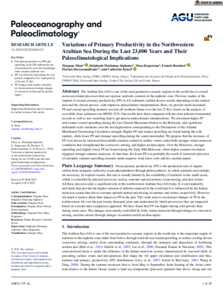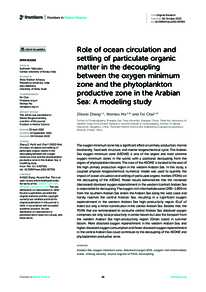وثيقة
Variations of primary productivity in the Northwestern Arabian Sea during the last 23,000 years and their paleoclimatological implications.
المعرف
DOI: 10.1029/2022PA004453
المصدر
Paleoceanography and Paleoclimatology. v. 37, 10, e2022PA004453
المساهمون
Kageyama, Masa., مؤلف
Bassinot, Franck., مؤلف
Doressoundiram, Florian., مؤلف
Kissel, Catherine., مؤلف
الدولة
United States.
مكان النشر
New Jersey
الناشر
John Wiley and Sons Inc.
ميلادي
2022-10-01
اللغة
الأنجليزية
الموضوع
الملخص الإنجليزي
The Arabian Sea (AS) is one of the most productive oceanic regions in the world due to several monsoon-related processes that can increase nutrients contents in the euphotic zone. Previous studies of the imprint of oceanic primary productivity (PP) in AS sediments yielded diverse results depending on the studied area and the chosen proxies, with unprecise paleoclimatic interpretations. Here, we provide multi-decennial PP and coastal upwelling dynamic records off northern Oman over the last 23 Kyr, based on the analysis of coccoliths from sediment core MD00-2354. Our results have been compared with previous paleoenvironmental records as well as new modeling data to get precise paleoclimatic interpretations. We document higher PP and weaker coastal upwelling during the Last Glacial Maximum relative to the Holocene, and significant millennial-scale variations over the last deglaciation corresponding to the fluctuations of the Atlantic Meridional Overturning Circulation strength. Higher PP and weaker upwelling are found during the cold stadials, while lower PP and stronger upwelling during the warm interstadial. We propose that the increases of PP were driven by increased bioavailable nutrient content in surface waters under both stronger winter monsoon conditions that strengthened the convective mixing, and higher aeolian inputs. Over the Holocene, stronger upwelling and slightly lower PP are found during the Early-Mid Holocene, when higher summer insolation triggered stronger summer monsoon. At that time, the lower PP was probably the result of restricted advection of eutrophic summer upwelling seawater under negative wind stress curls and less aeolian inputs.
ISSN
2572-4517
قالب العنصر
مقالات الدوريات


